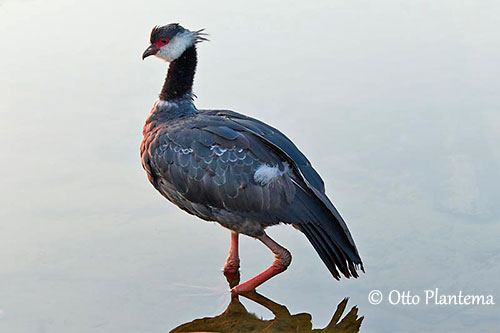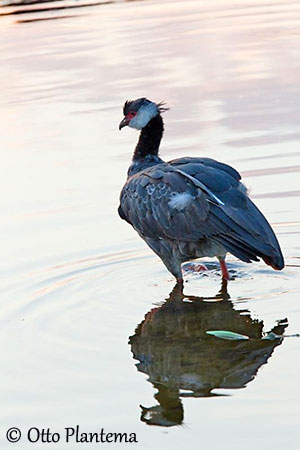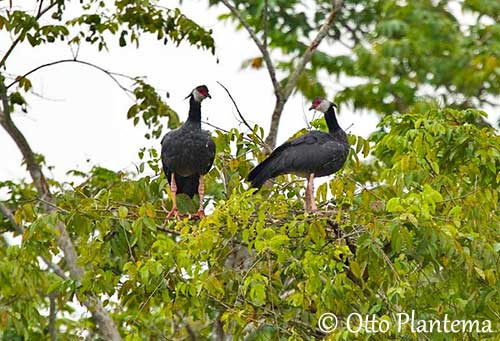
Fr: Kamichi chavaria
All : Weißwangen-Wehrvogel
Esp : Chajá Chicagüire
Esp (Colombia): Chavarrí
Esp (Venezuela): Chicagϋire
Ital : Kaimichi guancebianche
Nd: Witwanghoenderkoet
Sd: Svarthalsad värnfågel
Photographer:
Otto Plantema
Trips around the world
Text by Nicole Bouglouan
Sources:
HANDBOOK OF THE BIRDS OF THE WORLD vol 1 by Josep del Hoyo-Andrew Elliot-Jordi Sargatal - Lynx Edicions - ISBN: 8487334105
A GUIDE TO THE BIRDS OF COLOMBIA by Steven L. Hilty and William L. Brown - Princeton University Press – ISBN 069108372X
BirdLife International (BirdLife International)
Northern Screamer
Chauna chavaria
Anseriforme Order – Anhimidae Family
INTRODUCTION:
Its other name « Black-necked Screamer » indicates one of the main differences with the other screamers. The long black neck gives the Northern Screamer a touch of elegance when it walks slowly in marshy areas. Its reduced range added to habitat loss makes this species Near Threatened.
DESCRIPTION OF THE BIRD:
Biometrics:
Length: 76-91 cm
The adult is heavy-bodied, with blackish-grey breast, flanks and upperparts, whereas the lower underparts are slightly paler with indistinct whitish streaks.
The tail is black. The upperwing is blackish-grey with some narrow white streaks. We can see two sharp spurs on the bend of the wing, but the lower one is often hidden. The underwing shows white wing-coverts and blackish flight feathers.
On the head, the crown is grey. Several elongated grey feathers form a small crest on the nape. Chin, throat, cheeks and ear-coverts are white, forming a kind of broad, white chinstrap. The fairly long neck is black, with indistinct, narrow white collar at base.

Both sexes are similar in plumage, but the female is slightly smaller than the male.
The juvenile is duller than adults.
The chick has thick greyish-yellow down above and white below.
RANGE:
The Northern Screamer is found in N Colombia and NW Venezuela.
HABITAT:
The Northern Screamer frequents wet areas such as marshes, swamps, lagoons, banks of slow-flowing rivers and well-vegetated lakes, often surrounded by forest. It can be attracted by seasonally flooded plains too.
CALLS AND SONGS: SOUNDS BY XENO-CANTO
The Northern Screamer, like both other species, the Southern Screamer and the Horned Screamer, is very vocal and gives loud, unmelodious, repeated calls. These sounds are far-carrying. During the breeding season, both mates often perform duets.
It also calls white flying or when in groups. At nightime roost, they produce noisy chorus.
Both sexes utter gruff and guttural sounds, a kind of drumming used in threat displays. We can also hear a powerful bugled “kleer-a-ruk”.
BEHAVIOUR IN THE WILD:
The Northern Screamer is a vegetarian species feeding exclusively on plant matter such as roots, stems, leaves, tender parts of aquatic plants, seeds and grasses. It may occasionally take some insects.
This species grazes like all Anseriformes, but it sometimes digs with the bill for other food items. It is mainly diurnal. It can be seen resting in trees, perched at top, helped by its long toes.

During the breeding season, it calls loudly from tree top to proclaim the territory. Unlike most of other Anseriformes, screamers have long-term pair-bonds, and even for life. The territory is maintained and defended all year round against other birds’ species. It uses some threatening postures and guttural sounds. The spurs of the wings could be used during fights. Aerial pursuits to chase intruders away from the territory are observed too.
Mates often call in duet to establish the pair bond, and they perform mutual preening.
During the courtship displays, they walk side by side with the head almost touching the back. They produce low, coarse sounds, thanks to the subcutaneous air-sacs on both sides of the neck. Copulation takes place on the ground.
Outside the breeding season, they usually form loose groups.
The Northern Screamer is probably sedentary, although non-breeding birds and juveniles may wander, but rarely outside the usual range.
This species has largely terrestrial habits, but it is able to fly up to a tree top for resting or to escape a danger. It is a good flier, due to the long broad wings. However, the take-off needs heavy wingbeats. But once in the air, the bird glides easily with the neck outstretched.
REPRODUCTION OF THIS SPECIES:
They may breed throughout the year, with peak of laying in October/November.
The pair breeds solitary. The nest is a large accumulation of debris and vegetation such as sticks, reeds and weeds, collected around the nest-site. The nest is built by both adults, either in shallow water or on the dry ground close to the water.

PROTECTION / THREATS / STATUS:
The Northern Screamer has small populations and restricted range. It is threatened by degradation and habitat loss due to drainage of wetlands for pastures and agriculture. Illegal hunting, pollution and sewage in some areas can be added to the previous threats. There are about 1500-7000 mature birds.
This species is currently classified as Near Threatened.